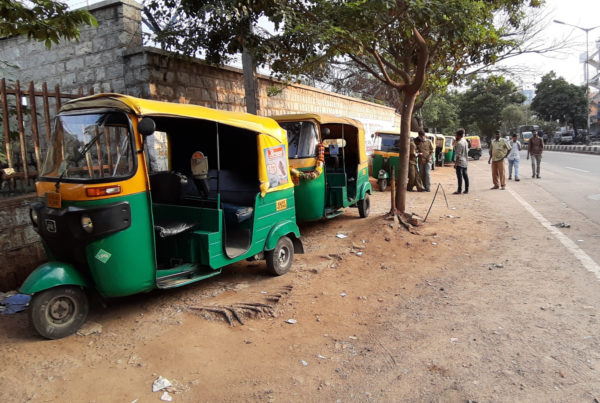Financial precarity and enduring poverty among India’s rickshaw drivers
This piece by PEAK Urban‘s Lucy Baker presents some of the findings of her research on digital technologies and mobility in India. This blog has been reposted from the PEAK Urban website.

Indian Prime Minister Narendra Modi has a vision to create a cashless economy as part of a public war waged against the nation’s ‘black economy’. A number of policies have been introduced that support the transition, the most well-known internationally being the demonetisation ordinance of 2016 which withdrew 86% of cash in circulation overnight and pushed the public towards digital money technologies. In the backdrop of Modi’s ‘100 Smart Cities Mission’, aimed at creating highly technical urban utopias, I am exploring the boundaries of an imaginary digital economy that is void of the irrationality of informal processes in financial, bureaucratic, urban planning and law enforcement institutions.
For the past year, as part of my Peak Urban research, I have been researching the emergence of digital money and Uber-like online transport booking services in the three-wheeled auto-rickshaw industry in Bengaluru, India.
I have witnessed huge gaps in provision to services, particularly for these low-income self-employed three-wheeled taxi drivers who are marginalised from regulated banking institutions and are forced to seek alternative financial arrangements at exorbitant costs. They provide important transportation services for the public designed to supplement the bus and metro systems. Yet these drivers are not financially supported in terms of infrastructure investment, salaries, health insurance, or retirement pensions.
Their jobs exist almost entirely because of deregulated and unregulated financial institutions. These institutions benefit from the precarity of these drivers who live day-to-day in perpetual cycles of poverty and debt, and it is passengers who must negotiate daily over fare rates and journeys.
In my interviews with financial institutions, staff told me that “many drivers default on their payments” and therefore “banks are not willing to loan drivers the finance required to purchase a vehicle”. Not only are drivers high-risk borrowers, the vehicles themselves account for part of the associated risk. On failure to complete a loan repayment, vehicles are traced and seized for auction to recover the loan and interest. However, on re-sale of a vehicle, recovering debt is not certain.
Moneylenders
The price of an auto-rickshaw is 180,000 rupees (about £2,000) and it will depreciate by 60,000 rupees (one third of its original value) within one year. Banks are unwilling to invest in second-hand vehicles because of the risk of engine failure and costly repairs. A second-hand vehicle’s value reflects not only a vehicle’s condition but also economic markets influenced by the ad-hoc introduction of new vehicle permits by the government, as well as a network of financers and brokers. Bank interest rates (8-11% per annum), therefore, cannot cover the risk associated with vehicle investment.
These factors leave drivers with little choice but to approach non-banking finance companies, who charge deregulated interest rates of about 16 to 24% per annum, or non-registered moneylenders who charge 24% and upward annual interest rates. The drivers’ dependency is determined by their lack of credit history and at times their legitimacy. Unregistered private financers are willing to lend to drivers without paperwork on reference by a known contact. A tightly knit network of agents, informants and vehicle seizers constantly work to chase-up late payments and to recover vehicles from defaulting drivers.
The police

Traffic police add another layer of complexity to drivers’ dependency on private moneylenders. The police regularly take small bribes rather than collecting full fines for offenses, such as operating shared services and failure to produce a driving licence, permit and/or a ‘display card’. In peripheral areas of the city where unemployment is high, and education levels are lower than average, informal services provide an opportunity for income and cheap transportation. However, this encourages drivers to enter the industry without the paperwork required by registered finance institutions.
Moneylenders and police
With a constant supply of customers, limited market competition, and the steady possibility of recovering drivers’ loans by seizing their relatively small and traceable vehicles, moneylenders are profiting from police corruption and loose law enforcement. The police often justify these actions on the grounds of compassion for those living in poverty and pressure for young men to be engaged in employment either legally, or illegally.
This leaves urban planners in a dilemma knowing that if police corruption and leniency in enforcing the law is taken seriously, then perhaps these deprived, peripheral, communities of the city could be worse off. However, in the end the continuing dependency on private unregulated (informal) and deregulated (formal) financial institutions is preventing the upward mobility of the poor. Informal and deregulated finance industries play a role in communities, yet they feed on precarity and poverty. Often the harassment faced by the poor whilst they remain dependent on informal money lending institutions can lead to cases of violence and even to family suicide pacts as can be traced in court proceedings and newspaper articles over the past year.
Passengers
The public are unaware of the complexity of why drivers are demanding higher fares than those set by government officials. This leads to a continuing dispute between desperate drivers and enraged passengers. For many drivers at least one month’s salary will be lost to interest fees each year. This expenditure is not recognised within the government stipulated fare rate. Harried passengers are unaware that loans are not a once in a lifetime entry into the driving industry, but are a regular part of drivers’ livelihoods that for the majority, do not lead to higher salaried opportunities.
In short, from my research, the lack of regulation in the finance industry, a tight network controlling vehicle markets and the lack of consistent law enforcement contributes to the ongoing reinforcement of socio-economic inequalities and the continued stigmatisation of auto-rickshaw drivers in Bangalore.